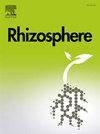Dicamba herbicide alters microbial community, metabolite composition, and nitrogen-cycling function in the wheat rhizosphere
IF 3.4
3区 生物学
Q1 PLANT SCIENCES
引用次数: 0
Abstract
Rhizosphere microorganisms are crucial for the growth and health of their host plants. Dicamba is one of the representative herbicides used for the control of wheat weeds. In recent years, the usage of dicamba has escalated globally, particularly with the advent of dicamba-tolerant transgenic crops. However, the impacts of this herbicide on non-target organisms, particularly the rhizosphere microorganisms of wheat, is not yet clear. Furthermore, rhizosphere microorganisms are important for nitrogen cycling in soil-crop systems, the influence of dicamba on rhizosphere nitrogen cycling functionality needs further investigation. This study aims to elucidate the effects of dicamba on the microbial community, metabolite profiles, and nitrogen cycling-related genes in wheat rhizosphere. Our findings indicated that dicamba led to significant alterations in the diversity and co-occurrence patterns of the rhizosphere microbial community, notably reducing the abundances of phyla Verrucomicrobia, Planctomycetes, and Cyanobacteria. Additionally, dicamba markedly disturbed the rhizosphere metabolite profiles, particularly those associated with carbohydrate and amino acid metabolism. Notably, dicamba treatment resulted in an up-regulation of enzymatic genes catalyzing processes of assimilatory nitrate reduction to ammonium (ANRA)/dissimilatory nitrate reduction to ammonium (DNRA) (EC: 1.7.5.1, EC: 1.9.6.1, and EC: 1.7.1.15) and denitrification (EC: 1.7.2.1 and EC: 1.7.2.5). The observed increases in the abundances of the genera Cellulosimicrobium and Pseudomethylobacillus were critical for facilitating ANRA and DNRA. The application of dicamba altered soil organic matter content, which in turn influenced the abundances of microorganisms involved in ANRA/DNRA and denitrification, thereby affecting the nitrogen cycling functionality in the rhizosphere. This study offers valuable theoretical support for assessing the rhizosphere ecological effects of agrochemical application.

求助全文
约1分钟内获得全文
求助全文
来源期刊

Rhizosphere
Agricultural and Biological Sciences-Agronomy and Crop Science
CiteScore
5.70
自引率
8.10%
发文量
155
审稿时长
29 days
期刊介绍:
Rhizosphere aims to advance the frontier of our understanding of plant-soil interactions. Rhizosphere is a multidisciplinary journal that publishes research on the interactions between plant roots, soil organisms, nutrients, and water. Except carbon fixation by photosynthesis, plants obtain all other elements primarily from soil through roots.
We are beginning to understand how communications at the rhizosphere, with soil organisms and other plant species, affect root exudates and nutrient uptake. This rapidly evolving subject utilizes molecular biology and genomic tools, food web or community structure manipulations, high performance liquid chromatography, isotopic analysis, diverse spectroscopic analytics, tomography and other microscopy, complex statistical and modeling tools.
 求助内容:
求助内容: 应助结果提醒方式:
应助结果提醒方式:


